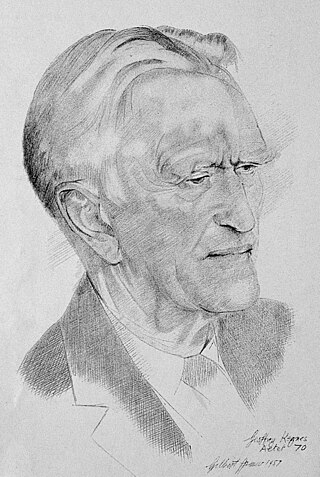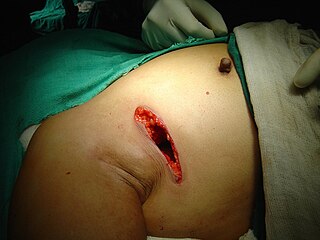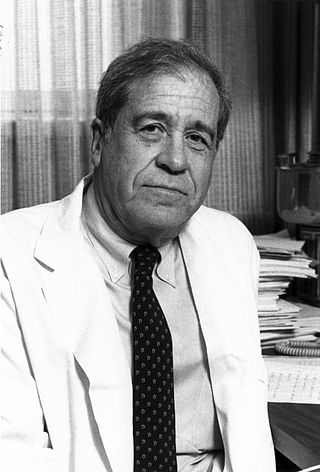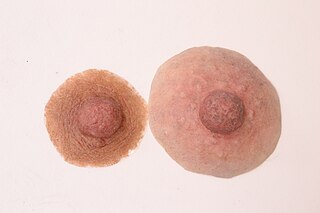Related Research Articles

Breast reconstruction is the surgical process of rebuilding the shape and look of a breast, most commonly in women who have had surgery to treat breast cancer. It involves using autologous tissue, prosthetic implants, or a combination of both with the goal of reconstructing a natural-looking breast. This process often also includes the rebuilding of the nipple and areola, known as nipple-areola complex (NAC) reconstruction, as one of the final stages.

General surgery is a surgical specialty that focuses on alimentary canal and abdominal contents including the esophagus, stomach, small intestine, large intestine, liver, pancreas, gallbladder, appendix and bile ducts, and often the thyroid gland. They also deal with diseases involving the skin, breast, soft tissue, trauma, peripheral artery disease and hernias and perform endoscopic as such as gastroscopy, colonoscopy and laparoscopic procedures.

Mastectomy is the medical term for the surgical removal of one or both breasts, partially or completely. A mastectomy is usually carried out to treat breast cancer. In some cases, women believed to be at high risk of breast cancer have the operation as a preventive measure. Alternatively, some women can choose to have a wide local excision, also known as a lumpectomy, an operation in which a small volume of breast tissue containing the tumor and a surrounding margin of healthy tissue is removed to conserve the breast. Both mastectomy and lumpectomy are referred to as "local therapies" for breast cancer, targeting the area of the tumor, as opposed to systemic therapies, such as chemotherapy, hormonal therapy, or immunotherapy.

Mammaplasty refers to a group of surgical procedures, the goal of which is to reshape or otherwise modify the appearance of the breast. There are two main types of mammoplasty:
- Augmentation mammaplasty is commonly performed to increase the size, change the shape, and/or alter the texture of the breasts. This usually involves the surgical implantation of breast implant devices.
- Reduction mammaplasty is commonly performed to reduce the size, change the shape, and/or alter the texture of the breasts. This involves the removal of breast tissue.

Sir Geoffrey Langdon Keynes was a British surgeon and author. He began his career as a physician in World War I, before becoming a doctor at St Bartholomew's Hospital in London, where he made notable innovations in the fields of blood transfusion and breast cancer surgery. Keynes was also a publishing scholar and bibliographer of English literature and English medical history, focusing primarily on William Blake and William Harvey.

William Stewart Halsted, M.D. was an American surgeon who emphasized strict aseptic technique during surgical procedures, was an early champion of newly discovered anesthetics, and introduced several new operations, including the radical mastectomy for breast cancer. Along with William Osler, Howard Atwood Kelly and William H. Welch, Halsted was one of the "Big Four" founding professors at the Johns Hopkins Hospital. His operating room at Johns Hopkins Hospital is in Ward G, and was described as a small room where medical discoveries and miracles took place. According to an intern who once worked in Halsted's operating room, Halsted had unique techniques, operated on the patients with great confidence and often had perfect results which astonished the interns.

Radical mastectomy is a surgical procedure involving the removal of breast, underlying chest muscle, and lymph nodes of the axilla as a treatment for breast cancer. Breast cancer is the most common cancer among women today, and is primarily treated by surgery, particularly during the early twentieth century when the mastectomy was developed with success. However, with the advancement of technology and surgical skills, the extent of mastectomies has been reduced. Less invasive mastectomies are employed today in comparison to those in the past. Nowadays, a combination of radiotherapy and breast conserving mastectomy are employed to optimize treatment.

Breast prostheses are breast forms intended to look like breasts. They are often used temporarily or permanently by women after mastectomy or lumpectomy procedures, but may also be used by for aesthetic purposes. There are a number of materials and designs; although, the most common construction is gel in a plastic film meant to feel similar to a person's skin. Prostheses may be purchased at a surgical supply store, pharmacy, custom lingerie shop, or even through private services that come to a person's home. There are many types of ready made breast prostheses including full or standard prostheses, partial prostheses such a shell prostheses, and stick on prostheses. Customized options are also available from specialty shops, which are moulded to fit an individual's chest by taking an impression of the breast(s). The areola and nipple may be replicated as part of the breast form or as separate nipple prosthesis. Both custom made and off-the shelf breast prostheses come in varieties that are designed to either be held in a pocket in a specially designed mastectomy bra or attached to the skin via adhesive or other methods and worn with a standard bra. There are many factors to consider when selecting breast prostheses such as different types and the care they require, insurance coverage, and psychosocial effects.

Breast-conserving surgery (BCS) refers to an operation that aims to remove breast cancer while avoiding a mastectomy. Different forms of this operation include: lumpectomy (tylectomy), wide local excision, segmental resection, and quadrantectomy. BCS has been increasingly accepted as an alternative to mastectomy in specific patients, as it provides tumor removal while maintaining an acceptable cosmetic outcome. This page reviews the history of this operation, important considerations in decision making and patient selection, and the emerging field of oncoplastic breast conservation surgery.
Rose Rehert Kushner was an American journalist and pioneering advocate for breast cancer patients. She wrote the 1975 book Why Me? What Every Woman Should Know About Breast Cancer to Save Her Life.

Bernard Fisher was an American surgeon and a pioneer in the biology and treatment of breast cancer. He was a native of Pittsburgh. He was Chairman of the National Surgical Adjuvant Breast Project at the University of Pittsburgh School of Medicine. His work established definitively that early-stage breast cancer could be more effectively treated by lumpectomy, in combination with radiation therapy, chemotherapy, and/or hormonal therapy, than by radical mastectomy.
Professor Kefah Mokbel FRCS is the lead consultant breast surgeon at the London Breast Institute of the Princess Grace Hospital, Professor (Honorary) of Breast Cancer Surgery at Brunel University London, an honorary consultant breast surgeon at St George's Hospital. Kefah Mokbel is the founder and current president of Breast Cancer Hope; a UK-based charity "dedicated to improving the quantity and quality of life in women diagnosed with breast cancer". He was appointed as a substantive consultant breast surgeon at St George's Hospital NHS trust in February 2001. He was named in Tatler magazine's Best Doctors Guide as one of the featured "Top Breast Surgeons" in 2006, 2007 and 2013. In November 2010 he was named in the Times magazine's list of Britain's Top Doctors.
Albert Salomon (1883–1976) was a Jewish-German surgeon at the Royal Surgical University Clinic in Berlin. He is best known for his study of early mastectomies that is considered the beginning of mammography. He was the father of the artist Charlotte Salomon, who was murdered in Auschwitz concentration camp during the Holocaust.
George Washington "Barney" Crile Jr. was an American surgeon. He was a significant influence on how breast cancer is treated and was a visible and controversial advocate for alternative procedures.

Nipple/Areola prostheses are made of silicone by breast prosthesis manufacturers and anaplastologists for breast cancer survivors who were treated for breast cancer with a mastectomy. Prostheses can be worn weeks after a mastectomy, breast reconstruction, or even nipple reconstruction. As an inexpensive and convenient alternative to surgery, patients may choose to wear them anytime during treatment. Patients who ultimately find nipple prostheses thought that they should be informed of them during the consultation prior to mastectomy.
A preventive mastectomy or prophylactic mastectomy is an elective operation to remove the breasts so that the risk of breast cancer is reduced.
Mark L. Smith is an American physician and plastic surgeon based in New York City. He is Chief of Plastic Surgery at Mount Sinai Beth Israel Beth Israel Medical Center, Director of Plastic Surgery for Continuum Cancer Centers of New York, Director, The Friedman Center for Lymphedema Research and Treatment, CoDirector of The Lipedema Project, and Professor of Surgery at Icahn School of Medicine at Mount Sinai. His areas of focus include microsurgical breast reconstruction, head and neck reconstruction, facial paralysis, reconstruction of congenital defects and the surgical treatment of lymphedema and lipedema.
Kristi Funk is an American breast cancer surgeon known for her surgical treatment of celebrities Angelina Jolie and Sheryl Crow and her advocacy of whole-food plant-based nutrition.
Raghu Ram Pillarisetti is an Indian surgeon, and the founder and director of KIMS-Ushalakshmi Center for Breast Diseases at KIMS Hospitals. Pillarisetti is the founder of Ushalakshmi Breast Cancer Foundation, a not-for-profit organisation, and Pink Connexion, a quarterly newsletter about breast healthcare.
Lisa J. M. Caldon is a British professor and clinical lecturer specialising in oncology. In her 20 year career, Caldon has published some 20 papers in the field of medicine. These have appeared in some of the top medical and peer-reviewed journals in Britain and abroad, including Medical Education, the European Journal of Cancer, the British Journal of Surgery, Patient Education and Counseling, Psycho-Oncology, Future Oncology, BMC Medical Informatics and Decision Making, and The Lancet Oncology. Caldon has worked at The University of Sheffield and with Cancer Research UK.
References
- 1 2 Narvaez, Alfonso A. (1991-06-15). "Dr. Jerome Urban, 77, Surgeon Who Specialized in Breast Cancer". The New York Times. ISSN 0362-4331 . Retrieved 2023-01-31.
- 1 2 Olson, James Stuart (2002). Bathsheba's breast: women, cancer & history . Baltimore: The Johns Hopkins University Press. pp. 75. ISBN 0-8018-6936-6.